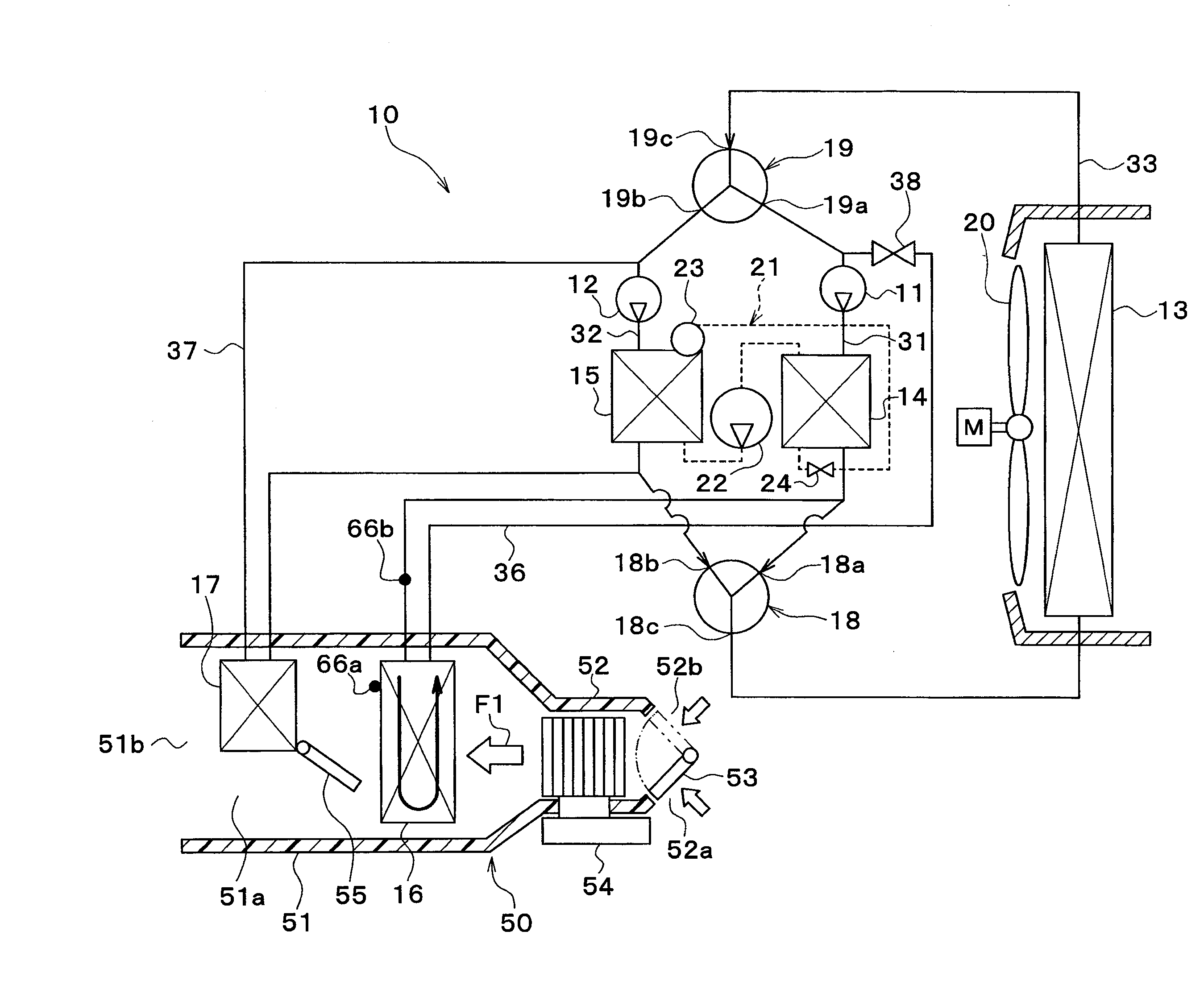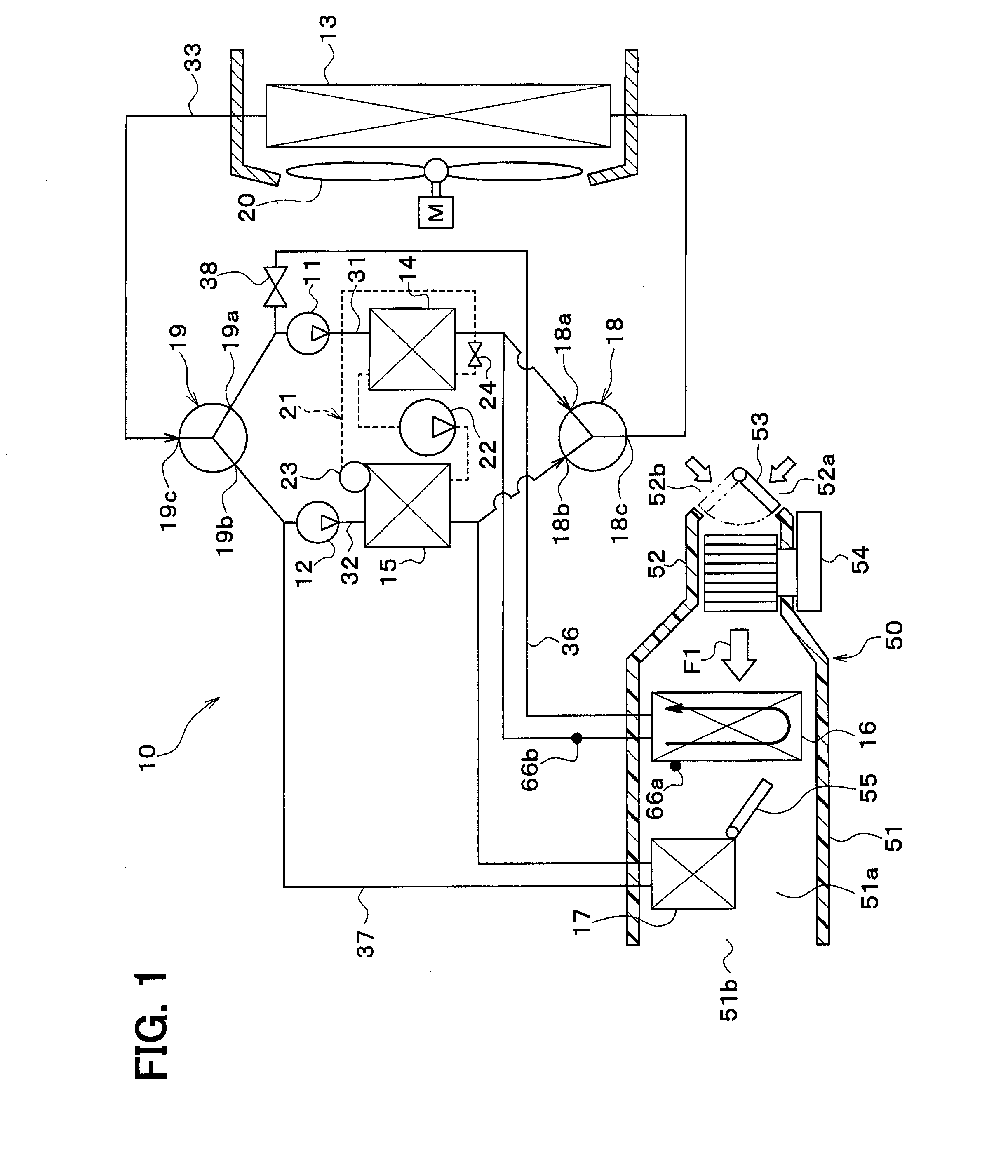Air conditioner for vehicle
a technology for air conditioners and vehicles, applied in vehicle heating/cooling devices, vehicle components, transportation and packaging, etc., can solve problems such as increased repair costs of exterior heat exchangers, leakage into vehicle interiors, and damage to exterior heat exchangers
- Summary
- Abstract
- Description
- Claims
- Application Information
AI Technical Summary
Benefits of technology
Problems solved by technology
Method used
Image
Examples
first embodiment
[0059]A vehicle thermal management system 10 illustrated in FIG. 1 is used to properly regulate the temperatures of a variety of devices included in a vehicle and a vehicle interior. In the embodiment, the thermal management system 10 is applied to a hybrid vehicle which obtains driving force for vehicle traveling from an engine (internal combustion engine) and a traveling electric motor.
[0060]The hybrid vehicle of the embodiment is a plug-in hybrid vehicle in which electric power supplied from an external power source (commercial power source) may be charged to a battery mounted in the vehicle (in-vehicle battery) when the vehicle is stopped. A lithium-ion battery may be used as an example of the battery.
[0061]The driving force output from the engine is used to drive the vehicle and to operate a generator. The electric power generated by the generator and the electric power supplied from the external power source may be stored in the battery. The electric power stored in the batter...
second embodiment
[0280]In the above first embodiment, the flow rate of coolant flowing in the cooler core 16 is controlled in the frost restriction mode. However, in the present embodiment, the coolant temperature flowing in the cooler core 16 is controlled in the frost restriction mode.
[0281]As illustrated in FIG. 17, an electric heater 70 is disposed in the cooler core passage 36. The electric heater 70 is a heating element which generates heat by electric power supplied. The coolant flowing in the cooler core passage 36 is heated by heat generated by the electric heater 70. The operation of the electric heater 70 is controlled by the controller 60.
[0282]In the embodiment, the configuration (hardware and software) for controlling the operation of the electric heater 70 in the controller 60 is referred to as an electric heater control unit 60h. The electric heater control unit 60h may be configured independently of the controller 60. The electric heater 70 and the electric heater control unit 60h a...
third embodiment
[0286]In the above second embodiment, the coolant temperature flowing in the cooler core 16 is increased by heating the coolant by the electric heater 70. However, in the present embodiment, the coolant temperature flowing in the cooler core 16 is increased by mixing coolant heated by the coolant / heater 15 with coolant cooled by the coolant / cooler 14, as illustrated in FIG. 18.
[0287]A first communication passage 71, a second communication passage 72, a first communication on-off valve 73, and a second communication on-off valve 74 are added to the embodiment.
[0288]The first communication passage 71 is a passage through which the coolant inlet-side portion of the cooler core 16 in the cooler core passage 36 communicates with the coolant inlet-side portion of the cooler core 16 in the heater core passage 37.
[0289]The second communication passage 72 is a passage through which the coolant outlet-side portion of the cooler core 16 in the cooler core passage 36 communicates with the coola...
PUM
 Login to View More
Login to View More Abstract
Description
Claims
Application Information
 Login to View More
Login to View More - R&D
- Intellectual Property
- Life Sciences
- Materials
- Tech Scout
- Unparalleled Data Quality
- Higher Quality Content
- 60% Fewer Hallucinations
Browse by: Latest US Patents, China's latest patents, Technical Efficacy Thesaurus, Application Domain, Technology Topic, Popular Technical Reports.
© 2025 PatSnap. All rights reserved.Legal|Privacy policy|Modern Slavery Act Transparency Statement|Sitemap|About US| Contact US: help@patsnap.com



